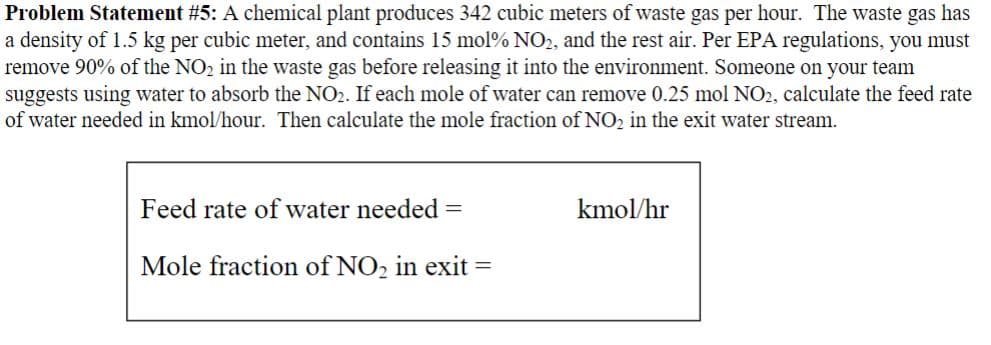Problem Statement #5: A chemical plant produces 342 cubic meters of waste gas per hour. The waste gas has a density of 1.5 kg per cubic meter, and contains 15 mol% NO2, and the rest air. Per EPA regulations, you must remove 90% of the NO2 in the waste gas before releasing it into the environment. Someone on your team suggests using water to absorb the NO2. If each mole of water can remove 0.25 mol NO2, calculate the feed rate of water needed in kmol/hour. Then calculate the mole fraction of NO, in the exit water stream. Feed rate of water needed = kmol/hr Mole fraction of NO2 in exit =
Problem Statement #5: A chemical plant produces 342 cubic meters of waste gas per hour. The waste gas has a density of 1.5 kg per cubic meter, and contains 15 mol% NO2, and the rest air. Per EPA regulations, you must remove 90% of the NO2 in the waste gas before releasing it into the environment. Someone on your team suggests using water to absorb the NO2. If each mole of water can remove 0.25 mol NO2, calculate the feed rate of water needed in kmol/hour. Then calculate the mole fraction of NO, in the exit water stream. Feed rate of water needed = kmol/hr Mole fraction of NO2 in exit =
Introduction to Chemical Engineering Thermodynamics
8th Edition
ISBN:9781259696527
Author:J.M. Smith Termodinamica en ingenieria quimica, Hendrick C Van Ness, Michael Abbott, Mark Swihart
Publisher:J.M. Smith Termodinamica en ingenieria quimica, Hendrick C Van Ness, Michael Abbott, Mark Swihart
Chapter1: Introduction
Section: Chapter Questions
Problem 1.1P
Related questions
Question
I am not sure how to approach this problem. I tried making the flow rate to kg/hr but I have no idea where to go from there. Mol% means mole percent.

Transcribed Image Text:Problem Statement #5: A chemical plant produces 342 cubic meters of waste gas per hour. The waste gas has
a density of 1.5 kg per cubic meter, and contains 15 mol% NO2, and the rest air. Per EPA regulations, you must
remove 90% of the NO2 in the waste gas before releasing it into the environment. Someone on your team
suggests using water to absorb the NO2. If each mole of water can remove 0.25 mol NO2, calculate the feed rate
of water needed in kmol/hour. Then calculate the mole fraction of NO, in the exit water stream.
Feed rate of water needed =
kmol/hr
Mole fraction of NO2 in exit =
Expert Solution
This question has been solved!
Explore an expertly crafted, step-by-step solution for a thorough understanding of key concepts.
This is a popular solution!
Trending now
This is a popular solution!
Step by step
Solved in 5 steps

Knowledge Booster
Learn more about
Need a deep-dive on the concept behind this application? Look no further. Learn more about this topic, chemical-engineering and related others by exploring similar questions and additional content below.Recommended textbooks for you

Introduction to Chemical Engineering Thermodynami…
Chemical Engineering
ISBN:
9781259696527
Author:
J.M. Smith Termodinamica en ingenieria quimica, Hendrick C Van Ness, Michael Abbott, Mark Swihart
Publisher:
McGraw-Hill Education

Elementary Principles of Chemical Processes, Bind…
Chemical Engineering
ISBN:
9781118431221
Author:
Richard M. Felder, Ronald W. Rousseau, Lisa G. Bullard
Publisher:
WILEY

Elements of Chemical Reaction Engineering (5th Ed…
Chemical Engineering
ISBN:
9780133887518
Author:
H. Scott Fogler
Publisher:
Prentice Hall

Introduction to Chemical Engineering Thermodynami…
Chemical Engineering
ISBN:
9781259696527
Author:
J.M. Smith Termodinamica en ingenieria quimica, Hendrick C Van Ness, Michael Abbott, Mark Swihart
Publisher:
McGraw-Hill Education

Elementary Principles of Chemical Processes, Bind…
Chemical Engineering
ISBN:
9781118431221
Author:
Richard M. Felder, Ronald W. Rousseau, Lisa G. Bullard
Publisher:
WILEY

Elements of Chemical Reaction Engineering (5th Ed…
Chemical Engineering
ISBN:
9780133887518
Author:
H. Scott Fogler
Publisher:
Prentice Hall


Industrial Plastics: Theory and Applications
Chemical Engineering
ISBN:
9781285061238
Author:
Lokensgard, Erik
Publisher:
Delmar Cengage Learning

Unit Operations of Chemical Engineering
Chemical Engineering
ISBN:
9780072848236
Author:
Warren McCabe, Julian C. Smith, Peter Harriott
Publisher:
McGraw-Hill Companies, The